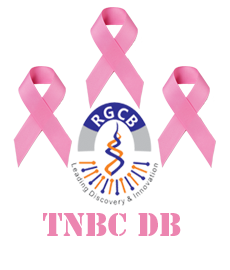
Triple-Negative Breast Cancer Database
FAQs
Why is it necessary to develop TNBCDb?
Gene expression based analysis by various research groups have resulted in the clustering of breast cancers into multiple groups of potential clinical utility. Clinically, the classification of breast cancers based on the positivity for ER, PR and HER2 is critical for evaluation of the therapeutic approaches. The cancers which are negative for these receptors, the Triple Negative Breast Cancers (TNBCs), have been characterized to be highly aggressive and recurrent with poor prognosis. Search for therapeutic targets across the population in this heterogeneous cancer subtype is challenging and urgently demands a catalogue of the molecular alterations that are reported from multiple studies. This would enable the researchers to study and develop a panel of molecular markers and/or targets and group patients into further subtypes for efficient targeted therapy. Towards this goal, we have initiated the development of the resource of molecular alterations in Triple Negative Breast Cancers. We wish to continue this effort by including more clinical parameters although is currently difficult to be extracted from published literature.-
What are the information currently available in TNBCDb?
TNBCDb currently hosts the alterations in expression of molecules at the level of microRNA, RNA, protein and phosphoprotein level in tissues and cell lines. The molecular alterations in tissues (TNBC- LN+/LN-/LN-metastasis) are available in comparison to normal (matched/unmatched) and also with other breast cancer types for which the data was available such as Luminal A, Lumina B, Her2+ and non-TNBC (if, not characterized or provided) tissues as been classified. We also catalogued the differential expression of genes and phosphorylations in various TNBC cell lines compared across them as well as with non-TNBC cell lines. Currently, the observed frequency of molecular alterations is also available in TNBCDb for molecular alterations, provided they were available/deducible from published literature. We believe that such information will help in the selection and characterization of further subtypes in TNBC and accelerate research on multiple targeted therapy options. -
Is basal-like breast cancer tissue considered as Triple Negative Breast Cancer
There is a substantial overlap between TNBC and the basal-like subtype of breast cancer (approx. 80%). However, only those 'basal-like cancer tissues' that are confirmed to be TNBC have been considered for the inclusion into TNBCDb. This is significant considering the early studies until the year 2009 where 'basal-like' were analyzed than 'TNBCs'. Molecules are not considered to be altered if not been compared with other types (non-TNBCs) or normal as a reference. -
Is data available with respect to the age, ethnicity and pre- or post- treatment?
Currently, we could not include the age and pre- or post- treatment parameters into the database due to the difficulty in extracting these information specific to TNBCs. However, we have documented the ethnicity wherever provided or could be deduced. -
Why was the comparison between cell lines considered?
Most of the resources that provide molecular alterations in specific cancers compare the regulation of molecules with respect to a normal cell line. TNBCDb is specific to TNBCs and the expression level of molecules in TNBC cell lines are compared with non-TNBC cell lines. As model systems for TNBC we believe that further classification of TNBC cell lines are warranted based on possible distinct patient cohort molecular subtypes. In order to enable such efforts, we have included the molecular alterations in established TNBC cell lines compared amongst them as well as with non-TNBC cell lines. -
Why is it that the age group(s) of the patients or tumor stage(s) not included?
We looked for this information in the literature; however, it was difficult to extract in the form that the data is provided in research articles for the TNBC categories. We now plan to communicate to the authors of the individual publications to acquire such information. -
What are the next levels of information that will be incorporated into TNBCDb?
Taking into account the quest for potential diagnostic/prognostic markers and considering immunohistochemistry as a major tool for detection, we intend to provide at first the list of proteins that are checked for positivity/negativity in tissues along with their observed frequency among the number of samples analyzed. We also intend to provide the splice variants in TNBCs in the subsequent version of the database. -
How can I download the data in TNBCDb?
You can either find the data in tab delimited format to download in the 'Downloads' bar in the TNBCDb page or you can click here which directs you to the Downloads page.
If you are interested in depositing data into TNBCdb, please click here .